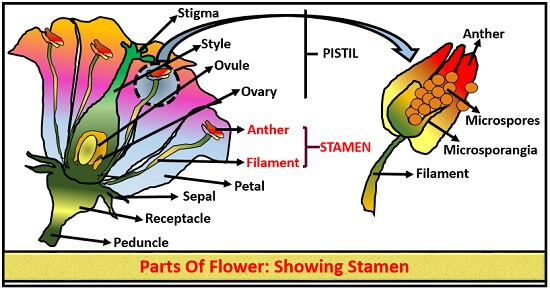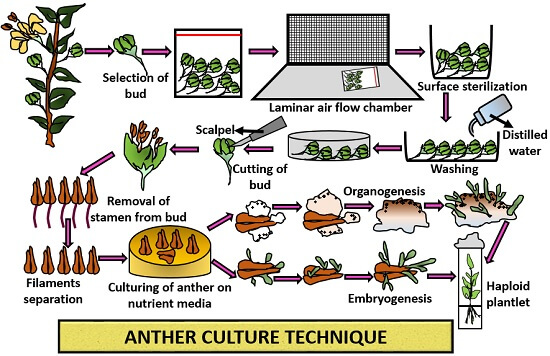Anther culture is a type of tissue culture technique, where a part of a plant (anther) gives rise to an androgenic haploid plant when cultured on a nutrient medium under optimal conditions. The nutrient media provide all the necessary factors that are required for the growth of the cell.
The anther culture technique comes under the process of Androgenesis that induce the growth of haploid plants. In about 250 species, the technique of the anther culture has been implemented. Among these 250 species, the most common species belongs to the family of Gramineae, Solanaceae, Ranunculaceae, Cruciferae etc.
It involves excision of the developing anther from the bud. The microspores of the anthers turn into the callus tissue, which in turn produce haploid plants. In this context, we will discuss the definition, method, procedure and factors influencing the anther culture technique along with its discoveries.
Content: Anther Culture
What is Anther?
The anther is a part of a flower, which is bilobed and sac-like in structure. In flower, anther is the part of the stamen that is a male reproductive part. Stamen comprises a long, narrow or stalk-like filament which carries the anther at its tip. An anther consists of microsporangia which produce pollen grains by the meiotic cell division.

Definition of Anther Culture
It is a method of Androgenesis, i.e. production of haploid plantlets by the in-vitro condition, in which the anther is separated from the bud aseptically and cultured on the nutrient media to give rise to the haploid plantlets. Its primary objective is to produce haploid androgenic plants by using the regeneration capacity or the totipotency of the anther.
History
Several discoveries have led to the discovery of producing haploid plantlets by the anther culture. Many scientists have contributed to know more of this technique by their experiments.
| Year of discovery | Discovered by | Name of the discovery |
|---|---|---|
| 1921 | Bergner | Introduced the existence of haploids in Datura stramonium |
| 1953 | W.Tulecke | Introduced the proliferation of haploid callus from the mature pollen grains of Ginkgo biloba |
| 1966 | Guha and S.C. Maheshwar | Confirmed the origin of haploid plantlets from the anther |
| 1967 | Bourgin and Hitsch | Discovered the full-fledged haploid plants from the Nicotiana tabacum. |
Methods
Anther culture is a plant tissue culture method, which can be done by either of the two methods, namely direct or indirect method.
- The direct method of an anther culture involves Embryogenesis. In this method, the anther behaves as a zygote and forms embryoid that eventually develops haploid plantlets.
- The indirect method of an anther culture involves Organogenesis. In this method, the anther undergoes cell division repeatedly to form the callus tissue, which later gives rise to the haploid plantlets.
Procedure of Anther Culture
There are following steps involved in the anther culture method:

- First, select the unopened buds of size about 17-22mm in length. Reject the buds that are beginning to open or already open. While selecting buds, the size of the sepal must be equal to the size of a petal, which is considered ideal for the anther culture.
- Transfer the buds into sterilized airtight plastic bags.
- Then, transfer the selected buds to the laminar airflow chamber.
- After that surface sterilization of buds is carried out in the chamber to maintain the aseptic conditions. Firstly, the buds are surface sterilized by 70% ethanol for 10 seconds and then 20% of sodium hypochlorite for 10 minutes.
- Then, wash the buds three times by the distilled water.
- After washing, transfer the buds to the sterilized Petri plate.
- Then, separate the stamen from the bud through a scalpel.
- Remove the filaments from an anther.
- After that, transfer an anther onto the solid or liquid nutrient medium and incubate it for 3-4 weeks at 24-28 ֯C in the dark.
- Then either by embryogenesis and organogenesis, haploid plantlets would appear from the anther culture within 3-4 weeks. During this stage, incubate the culture at 24-28 ֯C for 12-18 hours in light and 6-12 hours in the dark.
- At last, about 50mm tall plantlets will appear that are then transferred into the pot containing bio compost followed by washing. Then a sterilized glass beaker is used to cover the pot and remove the glass beaker after some week and transfer the plant to the large pot.
Factors Influencing Anther Culture
Some factors that influence the anther culture technique can be categorized into intrinsic and extrinsic factors.
Intrinsic Factors
Anther wall: It provides nourishment during the developmental stages of the anther.
Stage of Anther: For anther culture pre-mitotic, mitotic and post-mitotic stages of an anther is preferred. Pre-mitotic is the stage, in which the first meiotic division occurs in the anther and the pollens are at an immature stage. In the mitotic stage of an anther, there is the division of the pollen. The post-mitotic stage is the bi-cellular stage, where the development in pollen grains form embryoids.
Bud size: Its preferable size is up to the length of 17-22 mm.
Age of plant: The anther culture prefers the buds from the younger plants.
Extrinsic Factors
Culture medium: In the culture medium sucrose, iron, vitamins, coconut milk, hormones and growth regulators (auxins or cytokinins) play an essential role in the induction of haploid plant.
Temperature: It varies with the different plant species. Example: In Datura stramonium, the optimum temperature is 20 ֯ C for the formation of embryoids. In Nicotiana tabacum, the optimum temperature is 25 ֯ C for the formation of embryoids. In Brassica campentris, the optimum temperature is much higher, i.e. 35 ֯ C for the formation of embryoids.
Role of activated charcoal: Activated charcoal plays a vital role in the removal of inhibitory substances like both exo and endogenous growth hormones from the culture medium by stimulating anther growth.
Pre-treatment method: The pretreatment of bud is necessary for the production of embryoids. Example: In Nicotiana tabacum, the bud is pretreated at a temperature of 5 ֯ C for 72 hours.